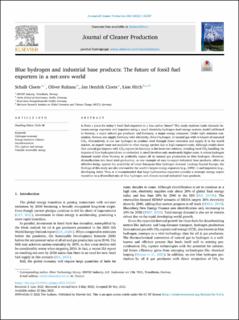| dc.contributor.author | Cloete, Schalk Willem Petrus | |
| dc.contributor.author | Ruhnau, Oliver | |
| dc.contributor.author | Cloete, Jan Hendrik | |
| dc.contributor.author | Hirth, Lion | |
| dc.date.accessioned | 2022-10-24T10:42:53Z | |
| dc.date.available | 2022-10-24T10:42:53Z | |
| dc.date.created | 2022-09-09T12:55:16Z | |
| dc.date.issued | 2022 | |
| dc.identifier.citation | Journal of Cleaner Production. 2022, 363 1-13. | en_US |
| dc.identifier.issn | 0959-6526 | |
| dc.identifier.uri | https://hdl.handle.net/11250/3027845 | |
| dc.description.abstract | Is there a place for today's fossil fuel exporters in a low-carbon future? This study explores trade channels between energy exporters and importers using a novel electricity-hydrogen-steel energy systems model calibrated to Norway, a major natural gas producer, and Germany, a major energy consumer. Under tight emission constraints, Norway can supply Germany with electricity, (blue) hydrogen, or natural gas with re-import of captured CO2. Alternatively, it can use hydrogen to produce steel through direct reduction and supply it to the world market, an export route not available to other energy carriers due to high transport costs. Although results show that natural gas imports with CO2 capture in Germany is the least-cost solution, avoiding local CO2 handling via imports of blue hydrogen (direct or embodied in steel) involves only moderately higher costs. A robust hydrogen demand would allow Norway to profitably export all its natural gas production as blue hydrogen. However, diversification into local steel production, as one example of easy-to-export industrial base products, offers an effective hedge against the possibility of lower European blue hydrogen demand. Looking beyond Europe, the findings of this study are also relevant for the world's largest energy exporters (e.g., OPEC+) and importers (e.g., developing Asia). Thus, it is recommended that large hydrocarbon exporters consider a strategic energy export transition to a diversified mix of blue hydrogen and climate-neutral industrial base products. | en_US |
| dc.language.iso | eng | en_US |
| dc.publisher | Elsevier | en_US |
| dc.rights | Navngivelse 4.0 Internasjonal | * |
| dc.rights.uri | http://creativecommons.org/licenses/by/4.0/deed.no | * |
| dc.subject | Variable renewable energy | en_US |
| dc.subject | CO2 capture and storage | en_US |
| dc.subject | Decarbonization | en_US |
| dc.subject | Energy-intensive industry | en_US |
| dc.subject | Hydrogen economy | en_US |
| dc.title | Blue hydrogen and industrial base products: The future of fossil fuel exporters in a net-zero world | en_US |
| dc.title.alternative | Blue hydrogen and industrial base products: The future of fossil fuel exporters in a net-zero world | en_US |
| dc.type | Peer reviewed | en_US |
| dc.type | Journal article | en_US |
| dc.description.version | publishedVersion | en_US |
| dc.rights.holder | © 2022 The Authors. Published by Elsevier Ltd. | en_US |
| dc.source.pagenumber | 1-13 | en_US |
| dc.source.volume | 363 | en_US |
| dc.source.journal | Journal of Cleaner Production | en_US |
| dc.identifier.doi | 10.1016/j.jclepro.2022.132347 | |
| dc.identifier.cristin | 2050298 | |
| dc.source.articlenumber | 132347 | en_US |
| cristin.ispublished | true | |
| cristin.fulltext | original | |
| cristin.qualitycode | 2 | |

